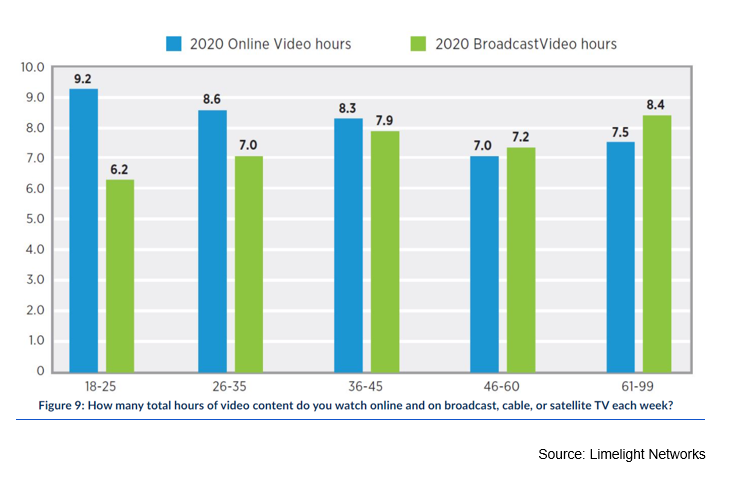Men and Women Ages 18-25 and 26-35 Spend More Time Playing Video Games than Watching Broadcast TV

Time is precious. Time is finite. Time is defined by an immovable boundary of 24 hours in a day and 365 days a year.
A media planner’s role is to reach consumers at the right time, in the right place, and with the right message. The time of day an ad is placed over the years has mattered. Media planners place ads during drive time. They plan and buy media for prime time. Ads in the first quarter of the Super Bowl, in the beginning of the game, are more expensive than ads at the end of the game. Time in media planning matters.
Reaching people when they are engaged in high-quality video content is a valued tactic for a media planner, whether that be through broadcast or online video, which has certainly shifted over the past several years. Limelight reports the average amount of time per week watching broadcast video is lower in all categories than online video hours with the exception of the 46-60 and 60+ categories. This is no surprise to a media planner trying to reach coveted audiences from 18-45.

What may be a surprise is that on average, people, both men and women, spend a significant amount of time playing games. Video gamers spend an average of six hours, 20 minutes each week playing games according to Limelight Networks State of Online Gaming. People who are playing video games are engaged in high-quality creative experiences, and one can argue they are more engaged than in a lean-back experience watching broadcast or online video. For argument's sake, let’s keep the comparison of the quality of the engaging content to another day.
Even more fascinating is when we compare the State of Online Gaming with Limelight Network State of Online Video 2020. In age brackets 18-25 and 26-35 the average weekly time spent playing games is higher than the average weekly time spent watching broadcast video, and not as far off from the average online video hours watched weekly as one might expect.

What we see from the data is a trend that is significant and here to stay. Playing video games is mainstream, at scale, and as we saw with the shift from online video to broadcast channels, here to stay as the younger generations’ patterns evolve to adulthood behaviours.
As we go back to our media planning roots, we look at time as a dimension to ensure we are reaching our valued audiences while they are doing the things they love in their own time.
Knowing the gaming audience has grown significantly, passing much of the valued segments in the broadcast video space, how do we reach gamers when they are playing games? What’s the best use of the gamers’ time to share a brand message?
There are two ways to reach gamers playing games: interruptive and intrinsic in-game ads.
Interruptive ads are the prevailing ad units for the in-game industry, which are placements such as interstitials, level-ups, or other ads placed outside of the game. Often these ad units can be seen as pausing the game, disruptive to the game, and tolerated only because the player wants to keep the free-to-play options, or at least reduce the price of the game by offsetting it some other way. These ads won’t go away, nor should they. They are a necessary part of the game development revenue stream. It’s a careful balancing act with the game developer to ensure they don’t alienate the gamer’s time by placing too many of these ads in their games.
Intrinsic ads enable brands to reach gamers inside the game play, integrating into the creative tapestry of the game design itself. These ad units do not interrupt the game during play. Instead, the game developer is in control of the ad placements to ensure they respect the gamer’s time. They reach gamers while they are playing the game, a valuable and uninterrupted and significant piece of time. This a new ad placement type that has not been monetized by game developers until now.
There are only 24 hours in a day. As a media planning community, we must embrace the fact that gamers 18-35 are spending more time playing video games than watching broadcast video. We should lean into connecting with the significant audience of gaming; in the U.S. alone it is 214 million people. Whether we choose to connect to these valuable gamers via in-game advertising using either interruptive or intrinsic in-game ads, all of us must play a role to ensure whatever method we use values and respects the gamers time.
Click the social buttons to share this story with colleagues and friends.
The opinions expressed here are the author's views and do not necessarily represent the views of MediaVillage.com/MyersBizNet.


